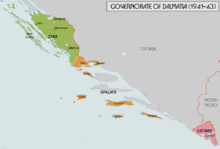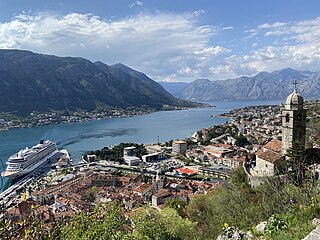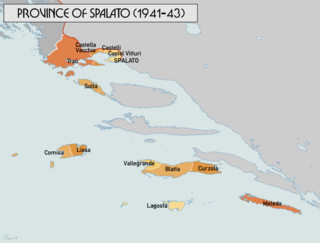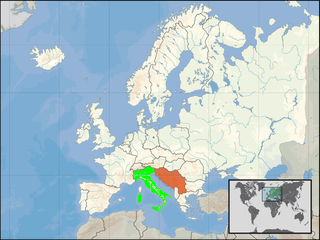
Province of Cattaro (Italian : Provincia di Cattaro) was a province of the Italian Governorate of Dalmatia, created in May 1941 during World War II (by the "Regio Decreto Legge del 18 maggio 1941" [1] ). It lasted until September 1943.

Province of Cattaro (Italian : Provincia di Cattaro) was a province of the Italian Governorate of Dalmatia, created in May 1941 during World War II (by the "Regio Decreto Legge del 18 maggio 1941" [1] ). It lasted until September 1943.

In April 1941, the Italians conquered coastal Dalmatia from the Kingdom of Yugoslavia. They created some provinces in that region that lasted until September 1943. One was the "Province of Cattaro", around the "Gulf of Cattaro". The administrative capital was the city of Cattaro (now Kotor). [2]
The province (subdivided in 15 "Comuni") had an area of 547 km2 and a population of 39,800 inhabitants. Prior to the war in 1931, the area consisted out of 13,000 Croats and 18,000 other (mostly Montenegrins and Serbs). [3] with a Dalmatian Italians minority. [4]
The Italians in summer 1941 improved the region by building hospitals and infrastructure, but started a process of Italianization (related to the history of Venetian Albania & the Republic of Venice [5] ). Because of this, after one year of peaceful administration & control, in summer 1942 there was a small insurrection against the Italian conquest, but without huge consequences until summer 1943.
In September 1943, the German army took control of the region from the Italians, who had surrendered to the Allies, and soon started a terrible guerrilla war between the Nazi occupiers and Josip Broz Tito's partisans. The province was abolished in the same September.

The 15 comuni were (first in Italian the official name and then in Croatian and Serbian the actual):

Dalmatia is one of the four historical regions of Croatia, alongside Central Croatia, Slavonia, and Istria, located on the east shore of the Adriatic Sea in Croatia.

Kotor, historically known as Cattaro, is a town in Coastal region of Montenegro. It is located in a secluded part of the Bay of Kotor. The city has a population of 13,347 and is the administrative center of Kotor Municipality.

The provinces of Italy are the second-level administrative divisions of the Italian Republic, on an intermediate level between a municipality and a region. Since 2015, provinces have been classified as "institutional bodies of second level".

The Bay of Kotor, also known as the Boka, is a winding bay of the Adriatic Sea in southwestern Montenegro and the region of Montenegro concentrated around the bay. It is also the southernmost part of the historical region of Dalmatia. At the entrance to the Bay there is Prevlaka, a small peninsula in southern Croatia. The bay has been inhabited since antiquity. Its well-preserved medieval towns of Kotor, Risan, Tivat, Perast, Prčanj and Herceg Novi, along with their natural surroundings, are major tourist attractions. The Natural and Culturo-Historical Region of Kotor was designated a UNESCO World Heritage Site in 1979. Its numerous Orthodox and Catholic churches and monasteries attract numerous religious pilgrims and other visitors.

The Independent State of Croatia was a World War II–era puppet state of Nazi Germany and Fascist Italy. It was established in parts of occupied Yugoslavia on 10 April 1941, after the invasion by the Axis powers. Its territory consisted mostly of modern-day Croatia and Bosnia and Herzegovina, as well as some parts of modern-day Serbia and Slovenia, but also excluded many Croat-populated areas in Dalmatia, Istria, and Međimurje regions.

Prevlaka is a small peninsula in southern Croatia, near the border with Montenegro, at the entrance to the Bay of Kotor on the eastern Adriatic coast.

Province of Spalato was a province of the Italian Governorate of Dalmatia, created in May 1941 during World War II. It lasted until September 1943.

Herceg Novi is a town in Coastal region of Montenegro located at the Western entrance to the Bay of Kotor and at the foot of Mount Orjen. It is the administrative center of the Herceg Novi Municipality with around 33,000 inhabitants. The town was founded as a fortress in 1382 by the King of Bosnia, Tvrtko I Kotromanić, and named after Saint Stephen but the name did not stick, instead it became known as Novi (transl. New), also Castelnuovo in Italian. Between 1482 and 1687 it was part of the Ottoman Empire and then from 1687 to 1797 the Albania Veneta of the Republic of Venice. It was a Catholic bishopric and remains a Latin titular see as Novi. Herceg Novi has had a turbulent past, despite being one of the youngest settlements on the Adriatic. A history of varied occupations has created a blend of diverse and picturesque architectural styles in the city.

Italian war crimes have mainly been associated with the Kingdom of Italy, Fascist Italy and the Italian Social Republic starting from the Italo-Turkish War then to Pacification of Libya, the Second Italo-Ethiopian War, the Spanish Civil War, and World War II.
The History of Dalmatia concerns the history of the area that covers eastern coast of the Adriatic Sea and its inland regions, from the 2nd century BC up to the present day. The region was populated by Illyrian tribes around 1,000 B.C, including the Delmatae, who formed a kingdom and for whom the province is named. Later it was conquered by Rome, thus becoming the province of Dalmatia, part of the Roman Empire. Dalmatia was ravaged by barbaric tribes in the beginning of the 4th century.

Poglavnik is a Serbo-Croatian word meaning "leader" or "guide".

The Italian governorate of Montenegro existed from October 1941 to September 1943 as an occupied territory under military government of Fascist Italy during World War II. Although the Italians had intended to establish a quasi-independent Montenegrin kingdom, these plans were permanently shelved after a popular uprising in July 1941. Following the Italian surrender in September 1943, the territory of Montenegro was occupied by German forces which withdrew in December 1944.

This is a survey of the postage stamps and postal history of Montenegro.

The Governorate of Dalmatia was an administrative division of the Kingdom of Italy established in from 1918 to 1920 and from 1941 to 1943. The first Governorate of Dalmatia was established following the end of World War I, given the London Pact (1915), and was disastablished following the Treaty of Rapallo. The London Pact also promised Italy part of Dalmatia. However, both the peace settlement negotiations of 1919 to 1920 and the Fourteen Points of Woodrow Wilson, who advocated self-determination, took precedence, with Italy being permitted to annex only Zadar from Dalmatia, with the rest of Dalmatia being part of Yugoslavia. Enraged Italian nationalists considered the decision to be a betrayal of the promises of the London Pact, so this outcome was denounced as a "mutilated victory".

The Province of Ljubljana was the central-southern area of Slovenia. In 1941, it was annexed by the Kingdom of Italy, and after 1943 occupied by Nazi Germany. Created on May 3, 1941, it was abolished on May 9, 1945, when the Slovene Partisans and partisans from other parts of Yugoslavia liberated it from the Nazi Operational Zone of the Adriatic Littoral. Its administrative centre was Ljubljana.

Italy–Yugoslavia relations are the cultural and political relations between Italy and Yugoslavia in the 20th century, since the creation of Yugoslavia in 1918 until its dissolution in 1992. Relations immediately after the end of World War I, and shortly before the rise of fascism in Italy, were severely affected and constantly tense due to the dispute over Dalmatia and the city-port of Fiume (Rijeka). Relations during the interwar years were hostile because of Italian demands for Yugoslav territory, contributing to decision by Italy and Germany to invade Yugoslavia during World War II. After lingering tensions after the war over the status of the Free Territory of Trieste, relations improved during the Cold War.

The Anti-Communist Volunteer Militia were paramilitary auxiliary formations of the Royal Italian Army composed of Yugoslav anti-Partisan groups in the Italian-annexed and occupied portions of the Kingdom of Yugoslavia during the Second World War.

Italian irredentism in Dalmatia was the political movement supporting the unification to Italy, during the 19th and 20th centuries, of Adriatic Dalmatia.

The Province of Zara was a province of the Kingdom of Italy, officially from 1918 to 1947. In 1941 it was enlarged and made part of the Italian Governorate of Dalmatia, during World War II, until 1943.